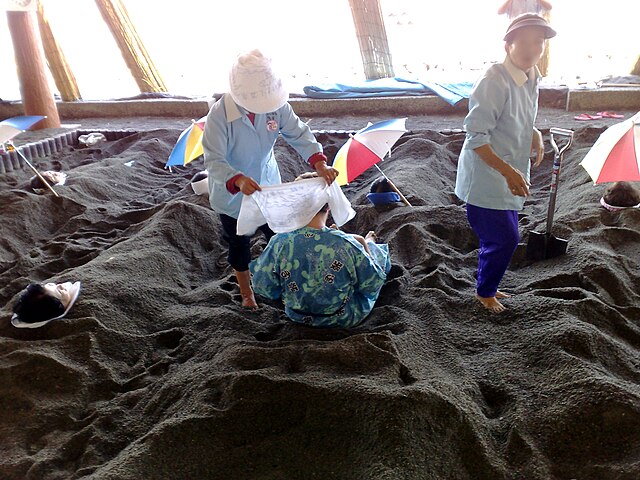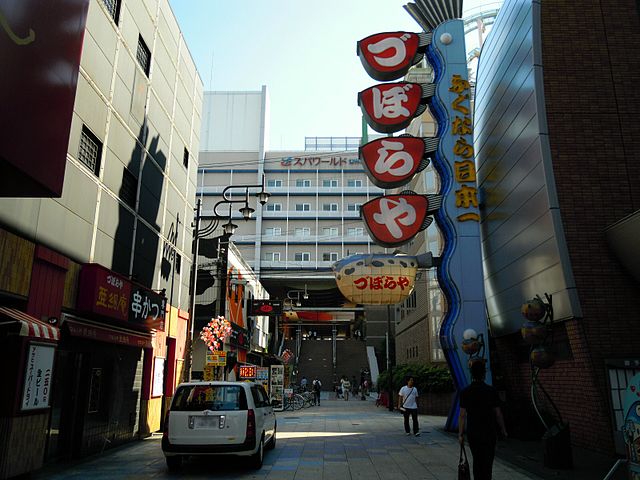Previously on Sekai Ichi, I described how to take a bath at an onsen, a common pastime for the Japanese. The only question for those whom I may have interested is, where to do it? Really, wherever there's water and a way to heat it, just about any place can serve as a good bath. But some places go the extra mile, in terms of the feel of their waters, the variety of baths on offer, and the overall ambiance of the place. That is how I'll be measuring my picks for the top ten onsen resort towns in Japan.
1) Ibusuki, Kagoshima Prefecture
 |
| Sand bathers in Ibusuki, and the attendants who help them. By Trinida (Own work) [GFDL or CC BY 3.0], via Wikimedia Commons |
- Saraku Sand Bath Hall. World-famous for sand baths, held right on the beach. Open from 8:30 AM to 9:00 PM. Costs ¥1,080 for a sand bath, or ¥610 for a hot-spring bath only. Website: (English)
- Healthy Land. Includes large open-air baths along the coast, in addition to sand baths. Open from 9:00 AM to 5:30 PM, or to 6:00 PM in July and August. Costs ¥1,240 for a sand bath, or ¥830 for a hot-spring bath only. Website: (English)
 |
| The "Umi-jigoku" spring in Beppu. By Totti (Own work) [CC BY-SA 4.0], via Wikimedia Commons |
- Takegawara. A historic public bathhouse offering sand baths. Open from 6:30 AM to 10:30 PM, closed on the 3rd Wednesday of December; sand bath open 8:00 AM to 10:30 PM, closed on the 3rd Wednesday of every month. Costs ¥110, or ¥1,050 for a sand bath. Website: (English)
- Tanayu / Suginoi Hotel. Includes rooftop open-air baths with wide views over the city, and a separate pool area, free with admission (swimsuits required). Open to non-staying guests from 9:00 AM to 11:00 PM. Costs ¥1,200 on weekdays, or ¥1,800 on weekends and holidays. Website: (English)
- Onsen Hoyo Land. Includes mud and steam baths, and a large, open-air mixed section. Open 9:00 AM to 8:00 PM. Costs ¥1,100. Website: (Japanese)
- Shoya no Yakaya (Yufuin). Uses vivid blue water, and offers beautiful views of the town below. Open to non-staying visitors from 9:30 AM to 6:30 PM. Costs ¥800. Website: (Japanese)
- Yamamizuki (Kurokawa Onsen). A secluded, serene inn with riverside outdoor baths. Open to non-staying guests from 8:30 AM to 9:00 PM. Costs ¥500. Website: (English) (Japanese)
 |
| The Dogo Onsen Honkan. By Japanexperterna.se (Own work) [CC BY-SA 3.0], via Wikimedia Commons |
- Dogo Onsen Honkan. Described above. Offers multiple pricing packages, with upper tiers including green tea and use of private relaxation rooms. Open from 6:00 AM to 11:00 PM. Costs ¥420. Website: (Japanese)
- Tsubaki-no-Yu. A simple public bath using the same water source as the Honkan. Open from 6:30 AM to 11:00 PM. Costs ¥400. Website: (Japanese)
- Asuka-no-Yu. Newly opened in 2017, it resembles a modern take on the Honkan, and offers indoor baths and private relaxation rooms. Open from 7:00 AM to 11:00 PM. Costs ¥610 to ¥1,690. Website: (Japanese)
Like the previous entry, Arima Onsen (有馬温泉) is also steeped in history, despite being situated only a half-hour from modern Kobe. It is famous for the two springs used throughout the town: the coppery "gold" water, and the clear "silver" water. For my report on Arima Onsen, please read this article. Recommended baths:
- Kin-no-Yu. A public bathhouse using the "gold" water. Open from 8:00 AM to 10:00 PM. Closed on the 2nd and 4th Tuesdays of each month, and on 1 January. Costs ¥650, or ¥850 for a combo ticket with Gin-no-Yu. Website: (English) (Japanese)
- Gin-no-Yu. A public bathhouse using the "silver" water. Open from 9:00 AM to 9:00 PM. Closed on the 1st and 3rd Tuesdays of each month, and on 1 January. Costs ¥550, or ¥850 for a combo ticket with Kin-no-Yu. Website: (English) (Japanese)
- Taiko-no-Yu / Arima View Hotel. A modern spa complex including both "gold" and "silver" water baths. Open 10:00 AM to 11:00 PM. Costs ¥2,640 on weekdays, or ¥2,860 on weekends and holidays. Website: (Japanese)
 |
| The baths of Suimeikan Karukaya, in Shin-Hotaka Onsen. By Soul of Japan [CC BY-SA 3.0], via Wikimedia Commons |
- Hirayu-no-Mori (Hirayu Onsen). Features a vast collection of outdoor baths nestled in the forest. Open from 10:00 AM to 11:00 PM. Costs ¥600. Website: (English) (Japanese)
- Okuhida Garden Hotel Yakedake (Shin-Hirayu Onsen). Features outdoor, mixed-gender baths with sulfur-tinted water. Open to non-staying guests from Noon to 10:00 PM. Costs ¥700. Website: (English) (Japanese)
- Yarimikan (Shin-Hotaka Onsen). A ryokan hotel featuring mixed-gender, open-air baths overlooking a river. Open to non-staying guests from 10:00 AM to 2:00 PM. Costs ¥500. Website: (English) (Japanese)
6) Hakone, Kanagawa Prefecture
 |
| Lake Ashi, with the torii gate of Hakone Shrine, and Mount Fuji in the back. By Kentagon [CC BY-SA 4.0], from Wikimedia Commons |
Hakone (箱根) is one of the closest onsen towns to Tokyo. As such, it features on many tourists' itineraries, but it warrants even multiple visits because it offers so much for guests to do. During the day, there are many art museums, sightseeing cruises across Lake Ashi, and the volcanic valley Owakudani. And then there are the dozen hot springs, feeding dozens upon dozens of baths. Of course, it's not surprising that there is so much geothermal activity, since Mount Fuji is within 30km (20 mi.) away, and in good weather, can be seen from a number of spots around Hakone. Despite the urbanised appearance of some establishments, especially around Hakone-Yumoto station, Hakone has a long and storied history as an onsen destination, and many of its outdoor baths nonetheless look out over tranquil forest landscapes. Recommended baths:
7) Kusatsu Onsen / Manza Onsen, Gunma Prefecture- Hakone Yuryo. A newer public onsen with baths overlooking a forested valley. Open from 10:00 AM to 9:00 PM (to 10PM on weekends). Costs ¥1,500. Website: (English) (Japanese)
- Hotel Kowaki-en Yunessun. A water park with uniquely-themed baths and pools (swimsuits required). Open from 9:00 AM to 7:00 PM. Costs ¥2,500. Website: (English) (Japanese)
- Mori-no-Yu. An annex of Yunessun, offering a more traditional onsen experience (no swimsuits). Open from 11:00 AM to 8:00 PM. Costs ¥1,500, or ¥3,500 in combination with Yunessun.
- Hakone Green Plaza Hotel. One of the (surprisingly) few outdoor baths in Hakone with views of Mt. Fuji. Open to non-staying guests from 1:00 PM to 6:00 PM (opens at 3:00 PM on Wednesdays and Thursdays, closes at 3:00 PM on weekends). Costs ¥1,600. Website: (English) (Japanese)
 |
| The yubatake (water field) in Kusatsu Onsen. By くろふね [CC BY 3.0], via Wikimedia Commons |
- Sainokawara Rotemburo (Kusatsu Onsen). Massive open-air baths in the middle of a forest near town. Open from 7:00 AM to 8:00 PM; opens at 9:00 AM from December through March. Costs ¥600. Website: (English) (Japanese)
- Otaki-no-Yu (Kusatsu Onsen). A public bathhouse in town, including side-by-side tubs of different temperatures. Open from 9:00 AM to 9:00 PM. Costs ¥900. Website: (English) (Japanese)
- Nisshinkan / Manza Hotel (Manza Onsen). The outdoor baths have wonderful views over the valley. Open for non-staying guests from 10:00 AM to 5:00 PM. Costs ¥1,000. Website: (English) (Japanese)
 |
| The Notoya ryokan at night. By Eiji Kikuta (AG2016) from Sendai, Japan [CC0 or CC0], via Wikimedia Commons |
- Shirogane-yu. A public bathhouse designed by architect Kuma Kengo. Open from 8:00 AM to 5:00 PM. Costs ¥500. Website: (English)
- Ginzan-so. A hotel near the front of town, with open-air baths overlooking a river. Open to non-staying guests from 10:00 AM to 1:30 PM. Costs ¥1,000. Website: (English) (Japanese)
- Takimi-kan. A ryokan nestled in the woods a short walk from town, with gorgeous outdoor baths. Open to non-staying guests from 11:00 AM to 2:00 PM. Costs ¥600. Website: (Japanese)
 |
| The outdoor mixed bath of Tsurunoyu Onsen, in wintertime. By Fumiaki Yoshimatsu from Tokyo, Japan (Akita) [CC BY-SA 2.0], via Wikimedia Commons |
- Tsurunoyu Onsen. The oldest onsen in the area, famous for its large outdoor mixed bath. Open to non-staying guests from 10:00 AM to 3:00 PM; closed on Mondays. Costs ¥600. Website: (English) (Japanese)
- Taenoyu Onsen. Includes outdoor mixed baths overlooking a nearby river. Open to non-staying guests from 10:00 AM to 3:00 PM; closed on Tuesdays. Costs ¥800. Website: (Japanese)
- Kuroyu Onsen. Includes outdoor mixed baths with nice sunset views of the surrounding woods. Open to non-staying guests from 9:00 AM to 4:00 PM. Closed from early November to mid-April. Costs ¥600. Website: (Japanese)
 |
| The jigokudani of Noboribetsu. By 663highland [GFDL, CC-BY-SA-3.0 or CC BY 2.5], via Wikimedia Commons |
- Daiichi Takimoto-kan. Makes the quite-plausible claim of being the largest spa in Asia. Its many baths use seven water sources, each with different mineral and healing properties. Open to non-staying guests from 9:00 AM to 6:00 PM. Costs ¥2,000, or ¥1,500 after 4:00 PM. Website: (English) (Japanese)
- Noboribetsu Grand Hotel. Includes indoor Romanesque baths, and outdoor baths overlooking a small waterfall. Open to non-staying guests from 12:30 PM to 8:00 PM; opens at 2:30 PM on Mondays and Thursdays. Costs ¥1,500. Website: (English) (Japanese)
- Sagiriyu. The only public bathhouse in town. Open from 7:00 AM to 10:00 PM, or to 9:00 PM from November to March. Costs ¥420. Website: (Japanese)
- Kinosaki Onsen, Hyogo Prefecture. A nostalgia-inducing onsen town near the Sea of Japan coast, with buildings straddling both sides of a willow-lined canal.
- Gero Onsen, Gifu Prefecture. An urbanised, but no less popular onsen town, and an easy day trip or stayover from Nagoya.
- Shibu Onsen, Nagano Prefecture. This town is right next door to Yamanouchi, home of the bathing snow monkeys. In fact, you may even see a few monkeys wandering down into town, although they generally have the good sense to stay out of the humans' baths.
- Minakami, Gunma Prefecture. A loose collection of baths around the woods of Mount Tanigawa. The region's highlight is the spacious mixed-bath of Takaragawa Onsen, the closest of its kind to Tokyo. Speaking of...
- Oedo Onsen, Tokyo. A modern public bath on one of the Odaiba islands, done up in Edo-period decor. Its natural spring water is piped in from over 1.4 kilometres (4,600 feet) beneath the Earth's surface.
 |
| By DVMG [CC BY 3.0], via Wikimedia Commons |


